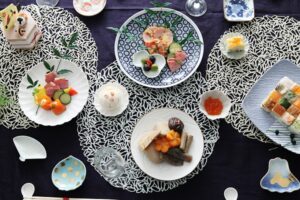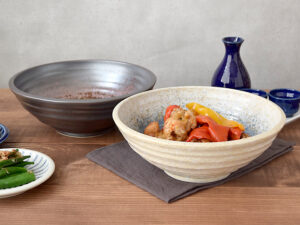Have you noticed that Japanese cuisine comes with a wide variety of dishware compared to western cuisine?
Today we will explain the types of the many Japanese dishware available and how to use them appropriately so you can incorporate them into their dishes to elevate the appearance of your food.
Types and uses of tableware
 Meshi-wan/Don (Rice bowl)
Meshi-wan/Don (Rice bowl)
A Meshi-wan is a bowl made for eating cooked rice. Most of them are made of ceramics, but some are also made of lacquer. The Don, which is about one size larger than a Meshi-wan, is convenient because it can also be used for noodles and soup dishes. Some Meshi-wan and Don come with a lid and can also be used for hospitality/decoration.
 Shiru-wan (Soup bowl)
Shiru-wan (Soup bowl)
A Shiru-wan is a bowl with a diameter of about 12 cm used for miso soup and other Japanese soups. These can be made from various materials such as affordable urethane coating all the way to full-scale lacquer ware (depending on the situation). A fancier lacquer soup bowl with a lid is used for New Year’s celebrations or hospitality.
 Hashioki (Chopstick Holder)
Hashioki (Chopstick Holder)
Hashioki or chopstick holder is a piece of dishware that helps hold the chopstick on the dinner table. It prevents the chopsticks from touching other dishes or the table. There are various designs and colors, used as an accent on the dining table. Many of them are reasonably priced, so it is convenient to have more than one according to the season.
Hira-Zara/Oo-zara (Flat/Large Plate)
Also called a shaku plate, it is a plate with a diameter of about 30 cm. Usually, it is used for shared dishes that is placed in the center of the table and set aside, but recently it has also used as a plate. It can also be used for noodles if it is deep enough.
Chūzara (Medium Plate)The Chuzara is also called a five-inch plate, a six-inch plate, and a seven-inch plate. Since 1 inch is about 3 cm, it is a plate of 15 to 21 cm in size that is often used in daily dishes. It is the most commonly used plate and can be used as a serving plate or as a main dish for one person.
Kozara/Mamezara (small plate/ Bean plate)
A plate with a diameter of 12 cm or less for a 3-inch plate or a 4-inch plate. It is used for sauce plates, soy sauce plates, and condiments. In addition, it can be widely used as a plate for separating Japanese sweets. There are many shapes and designs, and the price is relatively reasonable, so you can enjoy it if you arrange them in bulk. A bean dish of about 3 to 5 cm can also be used as a chopstick rest.
Tzunozara (square plate)
The square plate is suitable for serving sashimi and tempura. In addition, the longer square plates with long sides are used for grilled fish and appetizers. All dishes will be different, so this plate will be handy for the longer shaped dishes.


Hachi (pot)
A Hachi is a Large bowl. Like a platter, it is used to serve main dishes and special dishes.
 Ko-Bachi (small pot)
Ko-Bachi (small pot)
A container that is deeper than a plate. The depth varies depending on the product, and the deeper ones are used for soups such as hot pot dishes and simmered dishes. Also, for shallow dishes, it is suitable for serving side dishes for one person, such as spicy dishes, vinegared dishes, and soaked dishes.
 Futamono (lidded container)
Futamono (lidded container)
A container with a lid that is used to keep dishes from getting cold, such as chawanmushi (steamed pudding). In the summer, the whole bowl may be chilled and a cold appetizer may be added
 SobaChoku
SobaChoku
A soba choku is a tubular container with a diameter of 5 to 7 cm and a height of about 5 cm. It is a soup bowl for soba, but it can also be used for small bowls and teacups.
Cha ki (tea dishware)
Kyusu/Dobin(teapot)
There are two types of teapots the kyusu and dobin
The teapot with the vine handle is called the dobin, and the one with handle is on the side of the pot is called a kyusu. Both are tools for making tea. The Dobin is usually used for bancha, and the kyusu is usually used for sencha and gyokuro.


 Yunomi (Teacup)
Yunomi (Teacup)
A teacup for drinking Japanese tea, Chinese tea, etc. The temperature of tea varies depending on the type, so the thickness and size of the cup vary.
Shuki (Sake Cups)
Choshi and Tokkuri
“Choshi” is a metal or wooden container with a long handle that was originally used for new banquets and ceremonies such as San-san-ku-do. On the other hand, tokkuri are a medium sized container that contain sake and poured into smaller shot glass type cup called the inoguchi.
Guinomi and Inoguchi
The guinomi and ingouchi are the “cups” for the sake. The guinomi is a flatter wider cup (like a tiny plate) while the Inoguchi has a deeper top and a narrow bottom almost like a shot glass. Both are used for the purpose of drinking sake.

Misc.
Donabe (steel pot)
The Donabe is used for hot pot, cooking rice or in modern days, convection oven foods. It lasts a long time with proper use so investing in a one with good quality is key when buying one.
Tips for making your Donabe last longer:
- keep the outside of your Donabe dry at all times. This helps with preserving it longer.
- Heat up the pot slowly so you do not put unnecessary stress on it
- Do not put an empty donabe on heat because it might crack.
Shoyu-Sashi
A container used to store soy sauce on the side. It is a small teapot shaped container with two holes so you can pour adequate amounts of soy sauce on your food. The dishware is usually shared among the people eating with you so choosing a one that doesn’t drip is helpful since it keeps the container clean for everyone.
As you can see the types of Japanese dishes often differ depending on the dishes to be served. However, it is not necessary to have all the types introduced to “properly plate” Japanese food. Try testing around the various dishware and enjoy your own usage after knowing the purpose and role each plate plays.
The Bishamon Group Restaurants, especially Bishamon Japanese Restaurant and Tamon sushi use Japanese dishware to plate their foods. Please make sure to visit and enjoy both the wonderful looks and flavor of Japanese cuisine.
